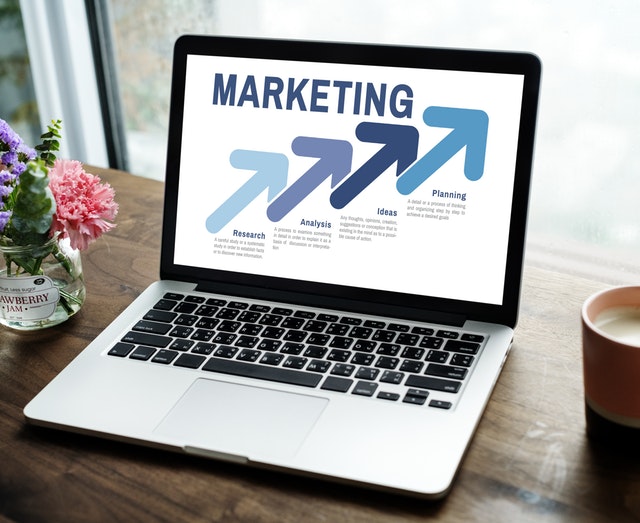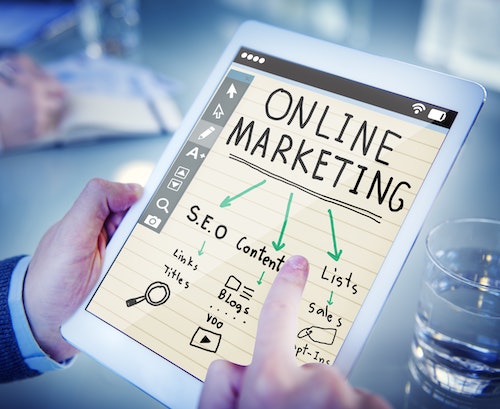Today, nearly 2 billion websites call the Internet home. Another 500,000 (give or take) will go live today, and tomorrow and the next. While many of these sites don’t directly compete in your space — retail furniture and home goods — that’s a lot of noise. Customers have to sift through it to find your website. That makes your site virtually invisible when it first goes live. But don’t get discouraged. This is why asking “what is eCommerce marketing” is so important. Marketing ecommerce websites is a challenge. That’s why we can help.
eCommerce marketing is how eCommerce sites get found. It’s how you build brand affinity and stay top of mind when someone’s in the market for a new sectional. It’s how you turn brand awareness into physical sales and profit. It helps you both solidify your presence in the community today and years down the road when your children take the reins.
Let’s explore what eCommerce marketing actually is and how you can use it to accomplish your goals.
What Is eCommerce Marketing?
eCommerce marketing is a set of online marketing methods designed specifically for eCommerce businesses.
But wait. You’re not an “eCommerce business”, you may be saying. You have one or more physical showrooms around the city. The website is just up to help you get more in-store sales.
That’s certainly true. Your website can help you get many more in-store sales. But as many brick and mortar stores often learn too late, it only does that if you treat your website like an eComm store by employing eComm marketing strategies.
When you do, your eCommerce business helps your business achieve big business goals like:
- Get more high-quality website traffic
- Improve brand awareness
- Increase revenues
- Increase customer lifetime value
- Get more referrals
- Get more foot traffic in the showroom
- Cut advertising costs
These things happen when you employ eCommerce marketing strategies. But let’s not confuse online advertising with marketing. Here’s a very important difference.
eComm Marketing Vs Online Advertising
Advertising is generally run in campaigns. It often focuses on making quick, and usually low value, sales now. If you stop running ads and promotions, sales may drop to a trickle. As a long-term strategy, this is very costly.
Marketing includes some advertising. But it has a larger focus. It endeavors to build something stronger and sustainable. It reaches people earlier in their customer journey.
eCommerce marketing guides them through:
- Discovering that they need something
- Considering their options both with you and their competitors
- Buying something
- Recommending you to others
- Becoming a repeat customer themselves
By reaching people earlier in this journey, you build trust and loyalty that translates to real profits. You create a sales funnel that continually draws in new customers from the top. Over time, this funnel gets stronger and stronger. Your customer referrals begin feeding the funnel. As the funnel becomes more self-sufficient, marketing and advertising costs in relation to revenues can even go down. This gives your business, your family and your employees a more sustainable future.
This may sound too good to be true. But when we break down the answer to “what is eCommerce marketing?”, you’ll see this is very attainable and manageable with the right strategies and execution. Let’s look at the marketing methods involved.
eCommerce Marketing Methods
It’s important to recognize that eCommerce marketing isn’t just one single method. Several marketing methods work together to achieve your marketing goals. As we go through this list, you may say to yourself, hey, this is just digital marketing with a new name.
You got us!
Yes, eCommerce marketing does use many tools also found in digital marketing. But the execution of an eComm strategy is very different from the broader world of digital marketing. Your understanding of those differences can make or break your website and business.
Some common methods used in eCommerce marketing include, but aren’t limited to:
- Search engine optimization (SEO) – Making your website more visible in searches
- Search advertising (aka: Google Ads)
- Remarketing – Showing a targeted ad to someone who already visited your website
- Social media marketing – Creating a business page and building a presence on one or more sites
- Social media advertising – Creating ads on Facebook and/or Instagram that target people in your community
- Permission-based email marketing – Collecting emails and sending regular offers and content to customers
- Influencer marketing – Great for eCommerce! Network with someone influential who will share your brand with their social media followers, sometimes for a fee and sometimes just because they love your store.
- Content Marketing – Creating content like blog posts, quizzes, videos that help people make furniture buying decision ( e.g., Take our home style personality quiz)
Yes, that sounds a lot like digital marketing. But how you use these methods matters. So, next, we’ll look at how these methods set themselves apart when built for eCommerce success that will drive your overall business success.
Promotion Strategies for eCommerce
Let’s break it down. Here are some of the specific strategies you can employ to promote your eCommerce furniture store. Before we get into these, it’s important to mention that one of the amazing things about eCommerce marketing is that you can track everything in nearly real time. Through analytics, it’s easy to see where to spend your money to get the best ROI long-term. We’ll start by looking at search marketing.
Search Engine Marketing (SEM)
SEM includes both SEO and search ads like those in AdWords. They work together to help people find your business first when they’re looking for something that you offer. While your long-term strategy should be to appear naturally in the search rankings, this takes months. Running ads in searches where you don’t yet appear gives an eCommerce site instant presence. As your ranking rises, you can reduce your Ad spend for those search terms and focus on others.
How do you use each to promote an eCommerce site? Let’s take a look!
SEO
Learn what helps websites like yours rank higher in searches. Then apply these strategies to improve your search presence.
Here are a few you must include:
- Create unique product descriptions that utilize keyword phrases that people are searching through Google. Adding compelling visuals to complement text. We suggest “draping”, which allow a person to select a color and see an item in that color. You don’t have to leave this to imagination any longer.
- Build a FAQ around common furniture questions. Use a keyword research tool to discover questions that people are searching for.
- Create online tools like a room design tool that helps people discover and design their space. Not only do these help customers make decisions and buy more. People often share tools on social media or link to it from their websites, which helps build your credibility with Google and customers.
- Create other content like blog posts, videos, quizzes and more to help customers make buying decisions. Not only are people looking for these kinds of resources in searches, which improves ranking over time. They give you an interactive platform to subtly convince prospects that you’re the business who should earn their business.
Build trust. Build loyalty. Do it by being helpful. It’s not a novel concept. Your sales team does it every day. This is how to do the same thing online.
PPC Ads
Pay per click (PPC) ads mean you only pay for the ad when someone clicks. Text ads can be effective in eComm. But you have to ask yourself, what is eCommerce marketing without display ads? Through AdWords, set these up so that they appear on Google’s partner sites. Or set up Google Shopping ads so that the images appear in Google search results.
eCommerce is very visual so anytime you can show instead of tell, you win with customers. Use a combination of text, display ads, Google Shopping ads, and remarketing ads to increase brand affinity and make more sales.
What is remarketing? We’re so glad you asked.

Remarketing
Once set up in AdWords or Facebook, you can automatically place a bit of code called a “cookie” on the device of someone who visits your website. This code communicates with the ad system to send a very relevant ad to this visitor after they leave your site.
In eCommerce, you’ll set up very targeted ads that show items that a person visited while on your site. Were they lingering for 20 minutes on that Victorian-style canopy bed only to leave the site, never to be heard from again?
You can set up remarketing ads that not only invite the person back to your site. Show a visitor a beautiful image of that specific canopy bed on Google or Facebook partner websites. Each time they see it, they remember how much they loved it. It welcomes them back until they either click or come into the store to buy it.
Social Media Marketing
Building a presence on social media gives you a channel to reach customers with your message and offerings on a regular basis. Over time, you build a fan base who love your brand and share what you share.
Social media marketing for eCommerce is:
- Highly focused on visuals – A picture is worth 1000 words. Your focus is to communicate your marketing message primarily through images and videos with the fewest words possible.
- Targeted to one community – It’s doesn’t pay to try to be everywhere in eCommerce. You’ll spread yourself too thin. Instead, do your homework. Determine one or maybe two social media platforms that are both easy to use and can reach your audience. For furniture, Facebook, Instagram and/or Pinterest are usually your best bet.
- Driven by reviews and referrals – Solicit Facebook reviews to increase social proof. This “subliminally” tells others you’re a business new customers want to do business with.
- Aware of the power of the customers to influence others- Facebook and Instagram are great platforms on which to run contests where people tag your products in posts with a certain theme for a chance to win a prize. User-generated content (UGC) and eComm go hand-in-hand. Find creative ways to get your customers to share your products on social media, normally accompanied by a selfie of them having fun. Not only does this drive real traffic to your eComm store. As you share and recognize the UGC of customers, you strengthen the loyalty those customers feel toward your brand. They want to share more. Free advertising is always a good thing!
- Aware of the power of celebrity – Network with a popular non-competitor, local business share each other’s posts to reach new audiences. Or pay a local “celebrity” to share a post now and again. “Celebrity” here can be loosely defined as someone who other people trust online and/or want to be like. You don’t need Kylie Jenner if you’re a local or regional brand. Think “practical” and “local” to get the most bang for your buck.
Now, let’s look at how ads can complement your social media marketing.
Facebook Ads
Use Facebook ads in several strategic ways to build a high-quality, local following and ultimately increase revenues, profits and the long-term viability of your brand. As a general rule, you should only target people in areas where you have a store to avoid having people click ads who will never become a customer. That’s a huge waste of money. Try this:
- Employ like campaigns. Contrary to how it sounds, a like campaign isn’t an ad asking for someone to like something. When a customer likes something that you share, the campaign sends an ad to their friends, letting them know they liked it and the friend should check it out too.
- Show visual ads in the feed that cause people to slow their scroll and check out your profile or site
- Use ads to run a contest if you don’t yet have a huge following. Obtain more emails for email marketing in this way.
- Showcase a new line in a slideshow ad.
Email Marketing
Permission-based email is by far the most cost-effective way to market eCommerce with an ROI of around $44 for every $1 you spend.
The only catch is that you have to earn that permission to send a person offers and helpful content. Abuse that permission and they will retract their permission. But play your cards right and you can drive insane eCommerce and foot traffic with email.
The reason email is so cost-effective is that almost everything can be automated. Through automation, send the right message to the right person at the right time.
Use email to:
- Remind a customer that they abandoned their cart
- Let a customer who hasn’t purchased in a while know that you miss them and offer them something special to come back
- Solicit feedback and reviews automatically
- Inform customers about current sales and promotions
- Make customers feel special with personalized offers based on their preferences or buying history
- Share fun videos you’ve uploaded to YouTube. Ask them to their thoughts on it.
- And much more
What Is eCommerce Marketing?
eCommerce marketing involves applying specific strategies to meet eCommerce business goals. While it employs many methods that you recognize as digital marketing, it’s defined by how you use these strategies specifically to reach eCommerce customers. Are you struggling to develop eCommerce strategy that works? Having trouble getting the ROI you need to increase sales and grow your business in the digital era. Find out how we can help you see eCommerce marketing in a whole new light by applying the right strategies for you.





